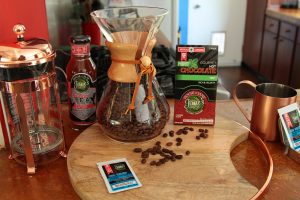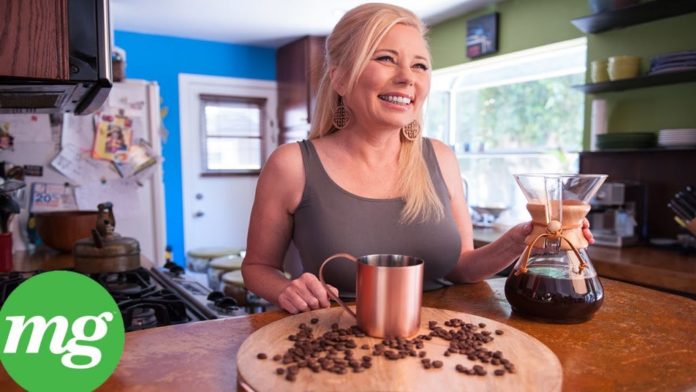Americans consume almost 400 million cups of coffee per day. There are more than 20,000 coffee shops across the nation. The cannabis industry is expected to be a $35 billion industry by 2020. What if you could marry coffee and cannabis? Jill Amen, co-founder, president, and the face of House of Jane, is on a mission to do just that.
It’s a picturesque sun-dappled early fall afternoon and I’m sitting at a sidewalk café in Los Angeles with Jill Amen, co-founder and president of House of Jane. She’s just ordered a goblet-sized frappe-something. Two ladies at another table are admiring her chic and groovy style (designer skinny jeans, vintage tank-top, high-heels, and exotic jewelry) and finally make their move. They approach the table and begin to chat and, inevitably, the “what do you do” question comes up. Jill’s blue eyes widen. Well… I own a cannabis coffee company.” The ladies’ eyes light up and they enthusiastically exchange cards. Jill smiles and winks at me: “This happens a lot.”
It’s not surprising. After spending just a few hours with Amen, it’s easy to tell she thoroughly enjoys making people happy, is very nurturing, and has great style. When she was a kid, she liked to serve people, and loved playing barista because “it’s fun to make special coffee and tea drinks.” Even as a child, she was a beverage connoisseur, pairing every meal with her favorite beverages. Her current favorite drink is HOJ’s chamomile tea.
After majoring in marketing and branding—both consumer and business-to-business—she went to work for Intel Corp. She did the usual post-first job routine: started companies including an ad agency, helped artists market themselves, and tried to help other friends realize their dreams. Although she has had a long, healthy relationship with cannabis—in college in the 1970s and early ’80s she experimented with edibles and cultivation—but she never thought there was a legit career in weed.
“I see things in a certain way,” she says, squinting into the sunshine. “I recognize what could be the ‘what if?’ of things. That is exactly how House of Jane came about. My family and I were in Amsterdam a few years ago and, although I love cannabis, I have never really enjoyed inhaling it. Therefore, I really started thinking about cultivating again, which I did. My first love, really. But then it came to me what a brand would look like—and if I could do it my way, what that would be. Hence, a cool but upscale premium product that would appeal to ‘a non-stoner’ like myself. I appreciate cannabis for what it does for the body and the mind. As a person who has a palate for delicious coffee, teas, and hot chocolates, it was easy for me to take that next step.”
JANEWOMAN
Over the past few years, as both the medical and recreational marketplaces have developed and edibles became the dominant seller, Amen sprang into action. She saw thousands of medical and recreational shops popping up and thought they’d be the perfect locations to launch her premium products.
“I have always approached a brand from a ‘me’ perspective when looking at the market: Feminine, fiercely independent, bold, carefree but responsible,” she says. “This is how I describe ‘Jane,’ my alter ego. I believe I market to people who can relate to this—both men and women, as there is a little bit of her in all of us.
“Jane is approachable, classy, fun-loving, spiritually in-touch, engaging, responsible, social, somewhat rebellious, and endearingly quirky.”
OPERATION DISPENSARY
Sensing a “movement,” Amen moved quickly to bring her “persona” into a marketplace that was at a tipping point for innovative launches. In a brief 18 months, many edible, beverage and concentrates companies went from brown paper bags with stickers on them to high-end, appealing, and eye-catching packaging and design that included in-store displays, tasting sessions, and clever marketing. Amen teamed with Ben-David Sheppard, an entrepreneur with more than 20 years’ experience as an executive recruiter with such notable clients as Steve Case, founder of AOL and former CEO of Time Warner; the Fortune 50 darling United Technologies Corp, and Under Armour, the fastest growing brand on the planet. Sheppard, HOJ’s co-founder and CEO, raised one million dollars from family and friends, and together the pair launched the company at Hempcon in January 2015, hoping to get a few bites from dispensaries. HOJ promptly won two awards and left with more than a dozen wholesale orders from California dispensaries. By June, HOJ had signed agreements with licensed growers in Nevada. HOJ products should be available by end of this year in Nevada and more recently HOJ has signed a deal with a 30,000 square-foot licensed grower in Arizona and hope to have their products on shelves in Arizona by December.
“Our coffee sales have been terrific,” Amen says. “I think we really hit the right market at the right time. Our products are not only for the existing cannabis consumer patient, but also for individuals just now exploring cannabis and what it can do for them. They are also looking for healthy wellness alternatives that don’t require smoking or vaping—or consuming high calorie, sugar-ridden edibles.”
One of Santa Cruz’s premier dispensaries, KindPeoples, began carrying HOJ products the very month it launched and has been reaping the rewards since. Inventory manager Liz Kreh has been pushing the coffee for patients who don’t smoke.
“It’s great because almost everybody loves coffee, and it’s even greater for patients that can’t smoke,” she says. “Medicated drinks can hit heavier than edibles, so patients have been satisfied on potency, too.”
HOJ is KindPeoples’ main vendor for coffee, and Kreh thinks the company has a very bright future: “I really believe they could get…big.”
Courtney Codd, of California’s The Cookie Co. 831 Collective, began stocking HOJ products October 1, 2015. The first day, the best-seller was easily the 20mg coffee pods. She’s bullish on HOJ’s future.
“HOJ is currently the only medicated coffee company that we sell,” she says. “I do think HOJ could dominate the medicated coffee market with the right marketing. It’s a crucial time for companies to gain a marketing foothold in the industry. I see them competing with companies like Green Mountain Coffee Roasting for a top spot in the medicated coffee and tea sector.”
It’s not just dispensary buyers who have been impressed. A longtime D.C. insider, a silent HOJ investor who asked to remain anonymous, said he was motivated to invest after simply “calling dispensaries in California and asking if they had ever heard of the company… The awareness stunned me.”
However, the management team in place sealed the deal. He was struck by their passion, drive, and attention to detail.
“I’ve never seen such drive and determination in a team,” he says from D.C. “In this industry, management dictates success.”
He’s a good ally to have. Keen to help shape good, workable, and sustainable policies as the industry matures, he has the connections to make a real difference.
To date, HOJ’s products (teas, hot chocolates, non-dairy creamers) are stocked in more than 130 dispensaries and collectives throughout California, from Redlands to Temecula. The company also works with top delivery services that help their patients who choose not to frequent the brick-and-mortar shops. In fact, the 20-some-odd employees at HOJ’s headquarters in San Jose are busy laying the groundwork to expand their distribution channels to Arizona, Colorado, Washington, and Oregon.
Cory Schwaderer is HOJ’s COO. He’s owned several successful businesses in the mainstream marketplace specializing in real-estate marketing, medical software, and computer hardware. He was also the owner of one of the first storefront mmj collectives in San Jose. As COO, he manages the day-to-day operations of both HOJ’s facilities and its team of brand ambassadors.
“Besides the normal business processes, I also communicate directly with many of our collective partners on a daily basis to ensure our products are being represented in the best possible way,” Schwaderer says.
He is especially proud of the company’s facilities. Although the general manager runs a tight ship, HOJ boasts a relaxed atmosphere where “employees thrive and exude a glowing, positive energy.”
LABS, THC, CAFFEINE, AND MONKEYS
It’s no surprise that a big part of the reason for HOJ’s recent growth has to do with the transparency and trust the company infuses in their vendors, something patients and customers, from coast-to-coast are now demanding. HOJ triple lab tests all their products using three different labs because “consistency is paramount.” They test the oil stage to make sure the product is perfectly calibrated and for microbes and other additives. Their second level of testing is at the powder stage, where they convert the oils to a powder form for manufacturing the product. Lastly, they test at the finished product level. (Lab testing partners include Steep Hill, CW Analytical, and SC Labs.)
“We post lab results every month—not all of them, however, because we have far too many—on our website so people can look at the results and feel secure that our products are free of pesticides or microbial issues,” Amen notes.
What about the effects of mixing cannabis and caffeine? Scientists discovered the interaction between coffee and cannabis quite by mistake. A recent study recorded the responses of squirrel monkeys given THC (delta-9 tetrahydrocannabinod), an active ingredient in marijuana. The monkeys quickly learned that pulling a lever triggered an intravenous release of THC from a small surgically implanted device. Taking this a step further, the scientists gave the monkeys doses of MSX-3, a water-soluble analog of caffeine. The monkeys, who were given the equivalent of less than half a cup of coffee, pulled the lever less often than normal. Those given more MSX-3, or the equivalent of one or more cups of coffee, pulled the lever even less frequently. The caffeine-analog caused the monkeys to need less THC to achieve the same effect. In short, indications are that caffeine allows cannabis users to smoke less and still achieve the same effect.
PREMIUM PROFITS

Asking anyone at HOJ who supplies their top-secret coffee beans produces a sly a smile and a polite “that info must stay proprietary.” But what they will say is this: They have selected a terrific medium roast: Mexican chiapps that is organically grown and has “very citricy, invigorating, bright, vibrant notes and a Mocha Café with deep, rich, chocolaty notes, smooth with sweet notes.” Coffee beans around HOJ are treated like wines in Napa or whiskey in Louisville.
“Our coffees are absolutely premium and are roasted locally and freshly ground,” Amen says. “Our processes keep the freshness. Our teas are also blended locally to our specifications. The taste and quality has to be amazing, or I won’t do it. Period. Our customers and patients really taste the difference and freshness in both our teas and coffees.”
There are three dose levels: 20mg for those with low tolerances or for less-experienced patients, 80mg for mid-range, and 200mg for patients seeking larger doses for therapeutic reasons. (“This is a big seller,” Amen says.) The coffee and teas have a slightly earthy taste, which is the cannabis. The aftertaste has been significantly reduced to the point where what results is a cannabis beverage that tastes terrific, first and foremost, and is not in any way overpowering with cannabis. HOJ thoroughly taste-tested everything before launching on a large scale to see what consumers liked best. Customers often comment on the great taste of the coffee flavors while noting “the earthiness of the cannabis is very subtle.”
While Amen spends a lot time travelling to trade shows and visiting with retail managers, Sheppard spends his days funding and developing national expansion and refining the company’s manufacturing and marketing initiatives.
“We recently brought on a very sophisticated New York investment team,” Sheppard says. “When we shared with them our product and plans for marketing and expansion—with the ultimate vision for a billion dollar company—they did not only not laugh at us and ask what were we smoking, they stepped up to join our team and invest!”
Sheppard is smiling. It’s obvious he’s confident he is shepherding a brand that could do very well and rocket to the top of American business lore.
This kind of fervor infuses the HOJ culture. Whether sponsoring the 420 games in Lake Tahoe or pouring their java and teas for events in Washington, D.C., Denver, and San Francisco, they are greeted with not only curiosity but also happy and welcoming taste buds. The staff is warm, passionate, and caring, with heapings of faith and loyalty. “A true family atmosphere with great integrity,” Sheppard says like a proud papa. (When not hustling for HOJ, he can be found coaching his 3 sons in football and lacrosse.)
Amen and Sheppard recently returned from a hobnobbing and sales trip to Colorado. When asked about their marketing strategy there, Sheppard quips, “Yes, I could tell you, but would have to… Only kidding.”
A closer look at the infused-coffee category reveals only a couple of other companies in the space—and if you ask Amen or Sheppard, they don’t really see any competition at all for HOJ. They have fully built-out marketing and sales departments in place and enough money in the investment till to execute their business strategy. But don’t tell Amen it’s a slam-dunk. She’s seen too much and knows there are always variables she can’t control.
“You never know what is going to happen next,” she says. “You have to keep an open mind, open heart, and be passionate about what you believe in.”
I can’t leave without bringing up the “S” word. It’s the proverbial big bean in the room. She takes a final gulp of her coffee and grins.
“Oh, yes, I have a vision!”
THE “S” WORD
The three founders of Starbucks had a vision, too, way back in 1971—a full two and one-half decades before the whole “coffee thing” really took off. The first Starbucks cafe was located at 2000 Western Avenue from 1971–1976. During this time, the company only sold roasted whole coffee beans and did not yet brew coffee to sell by the cup. The only brewed coffees served in the store were free samples. During the first year of operation, Starbucks purchased green coffee beans from Peet’s, and then began buying directly from growers. By 1987, the owners were ready to cash in: In 1987, they sold the Starbucks chain to former employee Howard Schultz, who rebranded his Il Giornale coffee outlets as Starbucks and quickly began to expand. In the same year, Starbucks opened its first locations outside Seattle. By 1989, forty-six stores existed throughout the Northwest and Midwest. Annually, Starbucks roasted more than 2 million pounds of coffee. At the time of its initial public offering in June 1992, Starbucks had grown to 140 outlets with revenues of $73.5 million; the company’s market value was $271 million.
Starbucks is one of the best examples of an American company with an early vision becoming a worldwide behemoth due to smart minds, able business decisions, patient investors, and a great product that took off at the right time. None of this is lost on Sheppard.
“House of Jane will be the greatest next-generation brand to be born from the end of cannabis prohibition—on par with the likes of Coke, Budweiser…and Starbucks,” he says.
Of course, there are numerous hurdles and obstacles to getting there. There’s the law, specifically. No one knows when—some say if—you’ll be able to go to a corner HOJ café to imbibe infused coffee and munch on goodies. How far are other countries behind the U.S. for recreational use? Will a company with superior infrastructure rush in and take the market by storm when it becomes more mature? When will the federal government ever fully legalize cannabis? Can the earth produce enough cannabis and coffee to meet the demand that would inevitably incur? Will HOJ be acquired?
“Being an MMJ company, we have faced several obstacles and will continue to do so,” notes Schwaderer. “Every municipality has their own set of rules and regulations, staying up to date on all the policy changes is a full-time job by itself. Until there is full recreational legalization, these obstacles will be ever-present.”
Right now, despite Canadian laws forbidding non-medical use, some cities and local law enforcement have tolerated coffee shops that allow customers to imbibe. In Toronto, there are a growing number of bring-your-own-cannabis coffee shops. Each Toronto café has its own set of rules and attitude, but all generally follow the rule 18 and older with ID at the door, no tobacco or hard drugs on the property, and no selling of cannabis on the premises.
In 2009, a local NORML chapter opened a cannabis-themed coffee shop in Portland, Oregon, accessible to members authorized under The Oregon Medical Marijuana Program. Cannabis is not available for sale, but is distributed freely for consumption on the premises. There also has been speculation about cannabis coffee shops opening in Colorado and Washington State, but nothing has come to fruition yet.
The only real obstacle the D.C. insider sees to HOJ becoming an international power brand in the next few years is legalization. “The way things are going, HOJ will be an international brand within five to seven years.”
Regardless the time frame, impediments can be jumped, sidestepped, bulldozed, and sometimes turned into advantages. Most importantly, laws do change.
History is usually kind to those with grit and doggedness. Biz Stone of Twitter likes to say, “Timing, perseverance and ten years of trying will eventually make you look like an overnight success.”
BEAN THERE, DONE THAT
As Amen finishes her coffee and checks her flight times, I can’t help but wonder: Is this woman sitting in front of me one day—ten, fifteen, twenty years down the line—going to be the president of the company that successfully married cannabis and coffee and, just maybe, become a worldwide brand on the scale of the companies Sheppard mentioned?
I’d take that bet, I think.
IMBIBE & BE BLISSFUL!
In addition to gourmet coffees, HOJ offers an impressive array of infused beverages to enjoy piping hot or over ice—anywhere, anytime therapy.
COFFEES
*Caffeinated Medium Roast
*Caffeinated Mocha Café
*Cappuccino Instant Caffeinated
TEAS
*Lightly Caffeinated Green Tea
*Naturally de-caffeinated Chamomile Tea
*Caffeinated Chai Tea
BOTTLED TEAS
*Sweet Black Tea
*Green Tea
*Unsweetened Tea
HOT CHOCOLATE
*Original Gourmet
*Mint
NON-DAIRY CREAMERS
*French Vanilla (won Best Edible and Connoisseur’s Choice Best Edible at HempCon Cup 2015)
 For wholesale orders: 1-855-420-JANE
For wholesale orders: 1-855-420-JANE












